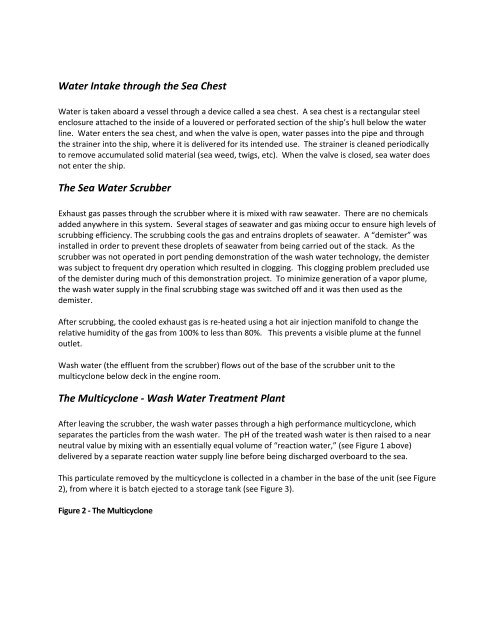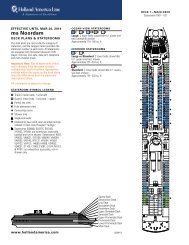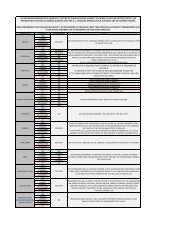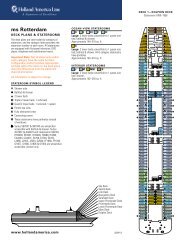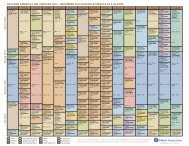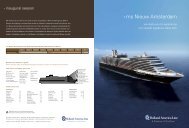Appendix D Overview of the Sea Water Scrubber System - Holland ...
Appendix D Overview of the Sea Water Scrubber System - Holland ...
Appendix D Overview of the Sea Water Scrubber System - Holland ...
Create successful ePaper yourself
Turn your PDF publications into a flip-book with our unique Google optimized e-Paper software.
<strong>Water</strong> Intake through <strong>the</strong> <strong>Sea</strong> Chest<br />
<strong>Water</strong> is taken aboard a vessel through a device called a sea chest. A sea chest is a rectangular steel<br />
enclosure attached to <strong>the</strong> inside <strong>of</strong> a louvered or perforated section <strong>of</strong> <strong>the</strong> ship’s hull below <strong>the</strong> water<br />
line. <strong>Water</strong> enters <strong>the</strong> sea chest, and when <strong>the</strong> valve is open, water passes into <strong>the</strong> pipe and through<br />
<strong>the</strong> strainer into <strong>the</strong> ship, where it is delivered for its intended use. The strainer is cleaned periodically<br />
to remove accumulated solid material (sea weed, twigs, etc). When <strong>the</strong> valve is closed, sea water does<br />
not enter <strong>the</strong> ship.<br />
The <strong>Sea</strong> <strong>Water</strong> <strong>Scrubber</strong><br />
Exhaust gas passes through <strong>the</strong> scrubber where it is mixed with raw seawater. There are no chemicals<br />
added anywhere in this system. Several stages <strong>of</strong> seawater and gas mixing occur to ensure high levels <strong>of</strong><br />
scrubbing efficiency. The scrubbing cools <strong>the</strong> gas and entrains droplets <strong>of</strong> seawater. A “demister” was<br />
installed in order to prevent <strong>the</strong>se droplets <strong>of</strong> seawater from being carried out <strong>of</strong> <strong>the</strong> stack. As <strong>the</strong><br />
scrubber was not operated in port pending demonstration <strong>of</strong> <strong>the</strong> wash water technology, <strong>the</strong> demister<br />
was subject to frequent dry operation which resulted in clogging. This clogging problem precluded use<br />
<strong>of</strong> <strong>the</strong> demister during much <strong>of</strong> this demonstration project. To minimize generation <strong>of</strong> a vapor plume,<br />
<strong>the</strong> wash water supply in <strong>the</strong> final scrubbing stage was switched <strong>of</strong>f and it was <strong>the</strong>n used as <strong>the</strong><br />
demister.<br />
After scrubbing, <strong>the</strong> cooled exhaust gas is re‐heated using a hot air injection manifold to change <strong>the</strong><br />
relative humidity <strong>of</strong> <strong>the</strong> gas from 100% to less than 80%. This prevents a visible plume at <strong>the</strong> funnel<br />
outlet.<br />
Wash water (<strong>the</strong> effluent from <strong>the</strong> scrubber) flows out <strong>of</strong> <strong>the</strong> base <strong>of</strong> <strong>the</strong> scrubber unit to <strong>the</strong><br />
multicyclone below deck in <strong>the</strong> engine room.<br />
The Multicyclone ‐ Wash <strong>Water</strong> Treatment Plant<br />
After leaving <strong>the</strong> scrubber, <strong>the</strong> wash water passes through a high performance multicyclone, which<br />
separates <strong>the</strong> particles from <strong>the</strong> wash water. The pH <strong>of</strong> <strong>the</strong> treated wash water is <strong>the</strong>n raised to a near<br />
neutral value by mixing with an essentially equal volume <strong>of</strong> “reaction water,” (see Figure 1 above)<br />
delivered by a separate reaction water supply line before being discharged overboard to <strong>the</strong> sea.<br />
This particulate removed by <strong>the</strong> multicyclone is collected in a chamber in <strong>the</strong> base <strong>of</strong> <strong>the</strong> unit (see Figure<br />
2), from where it is batch ejected to a storage tank (see Figure 3).<br />
Figure 2 ‐ The Multicyclone


